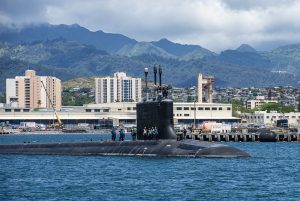Australia decided to invest in U.S. nuclear-powered submarines and dump its contract with France to build diesel-electric submarines because of a changed strategic environment, Prime Minister Scott Morrison said on Thursday.
President Joe Biden on Wednesday had announced a new U.S. security alliance with Australia and Britain that would develop an Australian nuclear-powered submarine fleet.
As a result, Australia notified France that it would end its contract with state majority-owned DCNS to build 12 of the world’s largest conventional submarines. Australia has spent 2.4 billion Australian dollars ($1.8 billion) on the project since the French won the contract in 2016.
Morrison said U.S. nuclear submarine technology wasn’t an option open to Australia when the A$56 billion ($43 billion) deal was struck in 2016. The United States had until now only shared the technology with Britain.
Morrison said he told French President Emanuel Macron in June that there were “very real issues about whether a conventional submarine capability” would address Australia’s strategic security needs in the Indo-Pacific.
“Of course they’re disappointed,” Morrison said. “They’ve been good partners. This is about our strategic interest, our strategic capability requirements and a changed strategic environment and we’ve had to take that decision.”
Australian Defense Force Chief, Gen. Angus Campbell, welcomed the new submarines.
“Our strategic environment has deteriorated,” Campbell said. “That challenging environment is becoming more challenging and is set to do so into the future at an accelerated pace.”
Australia had not yet decided what class of submarine it would select and did not know how much the nuclear fleet of at least eight submarines would cost, Morrison said.
But Morrison said Australia’s defense budget would grow above the current 2.2 percent of gross domestic product.
Unlike the nuclear-powered variety, conventional submarines on long transits from Australia to potential conflict zones in the Asian region have to spend time traveling on the surface where they are at their most vulnerable using diesel engines while they recharge their batteries. The batteries propel them underwater.
Admiral Chris Barry, a former defense force chief, said the French and U.S. versions would have similar on-board capabilities, weapons, and sensors.
“But what we will acquire is better transit speeds and a greater operational endurance,” Barry said.
“Endurance in a nuclear-powered submarine is limited by the patience of the crew and the amount of food on board and of course it’s still limited but much, much greater (endurance) than what we acquire in a conventional submarine,” he added.
Australia’s submarine upgrade was a response to China’s takeover of the South China Sea, aggressive bullying of Australia, and intimidation of Japan and Taiwan, said Peter Jennings, executive director of the Australian Strategic Policy Institute think tank.
“We should call the first submarine in this new category the ‘Xi Jinping,’ because no person is more responsible for Australia going down this track than the current leader of the Chinese Communist Party,” Jennings said.
The first of the 97-meter Shortfin Barracuda submarines, an adapted French nuclear sub design, was to be delivered in 2027.
Morrison said he expected the first of nuclear subs, which are to be constructed in the Australian city of Adelaide, would be built by 2040.
French Foreign Minister Jean-Yves Le Drian on France-Info radio Thursday expressed “total incomprehension” at the move and criticized both Australia and the United States.
“It was really a stab in the back. We built a relationship of trust with Australia, and this trust was betrayed,” Le Drian said.
“I’m angry today. This is not done between allies,” he added. “We are demanding explanations from both sides.”
Left out of the new alliance was Australia’s South Pacific neighbor New Zealand, which in the 1980s enacted policies and laws to ensure it remains nuclear-free. That includes a ban on nuclear-powered ships entering New Zealand ports, a stance which has seen it clash, at times, with the U.S.
Prime Minister Jacinda Ardern said Thursday that New Zealand wasn’t asked to be part of the alliance and wouldn’t have expected an invitation.
“The centerpiece, the anchor of this arrangement are nuclear-powered submarines,” Ardern said. “And it will be very clear to all New Zealanders, and to Australia, why New Zealand would not wish to be a part of that project.”
Ardern said the new alliance didn’t diminish its close ties to the U.S., Britain, Australia, and also Canada, which had been solidified through the Five Eyes intelligence-sharing arrangement.
Morrison said Ardern was the first foreign leader he called to explain the new alliance. He later called the leaders of Japan and India. The two countries combined with the United States and Australia form the Quad security dialogue.
“She was my first call because of the strength of our relationship and the relationship between our countries,” Morrison said. “All in the region will benefit from the peace and the stability and security that this partnership will add to our region.”
The Chinese government has long suspended minister-to-minister contact with Australia because of soured bilateral relations. But Morrison said he was willing to discuss the new alliance with President Xi Jinping.
“There’s an open invitation for President Xi to discuss these and many other matters,” Morrison said.
“I believe and hope we would both share the same objective of a peaceful Indo-Pacific where the sovereignty and independence of nations is understood and respected and that enables their own citizens to flourish,” he added.
China’s Washington, D.C., embassy spokesman Liu Pengyu said countries should not build exclusionary blocs targeting or harming the interests of third parties.
“In particular, they should shake off their Cold War mentality and ideological prejudice,” he said.
Australia would become the first country without nuclear weapons to obtain nuclear-powered submarines.
Australia would discuss with the U.S, and Britain how the submarines’ nuclear waste should be disposed, Defense Department Secretary Greg Moriarty said.

































